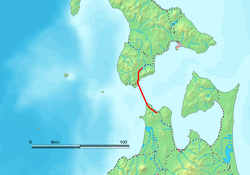Seikan Tunnel facts for kids
 |
|
| Map of the Seikan Tunnel | |
| Overview | |
|---|---|
| Location | Beneath the Tsugaru Strait |
| Coordinates | 41°18′57″N 140°20′06″E / 41.3157°N 140.3351°E |
| Status | Active |
| Start | Honshu |
| End | Hokkaido |
| Operation | |
| Owner | Japan Railway Construction, Transport and Technology Agency |
| Operator | JR Hokkaido |
| Character | Passenger and freight |
| Technical | |
| Track length | 53.85 kilometres (33.46 mi) (23.3 kilometres (14.5 mi) undersea) |
| No. of tracks | Double track rail tunnel |
| Gauge | Dual gauge (1,435 mm (4 ft 8 1⁄2 in) standard gauge for Shinkansen trains & 1,067 mm (3 ft 6 in) narrow-gauge for freight trains) |
| Electrified | 25 kV AC, 50 Hz |
| Operating speed | 160 km/h (100 mph) |
The Seikan Tunnel (pronounced Say-kahn) is an amazing railway tunnel in Japan. It connects the large island of Hokkaido to Aomori Prefecture on the island of Honshu. This incredible tunnel is the second longest transport tunnel in the world.
The Seikan Tunnel stretches for 53.85 km (about 33.5 miles). A huge part of it, 23.3 km (about 14.5 miles), goes deep under the sea! It was a huge engineering challenge to build.
Contents
Building the Seikan Tunnel
Before the Seikan Tunnel was built, people traveled between Hokkaido and Honshu by ship. This journey took about three hours. However, traveling by sea could be dangerous. For example, in 1954, a big storm called Typhoon Number 15 Roke caused the Toya Maru ship to sink. More than 1,100 people died or went missing in that accident.
Because of these dangers, people really wanted a safer way to travel. So, the idea of building the Seikan Tunnel became a reality. Engineers looked at different paths for the tunnel. They chose the "west route" because the water there was not as deep (about 140 meters). Also, the ground under the sea was easier to dig through.
How the Tunnel Was Built
Building a tunnel so long and deep under the sea was very difficult. Workers had to worry about seawater leaking in. To solve this, they used many new and clever building methods.
They used special tools like laser measurement to dig very precisely. They also drilled horizontally for long distances, up to 2,150 meters. To make the soft ground strong and stop water, they poured special mixtures like water glass and cement into the rocks. These new techniques were very impressive and caught the attention of engineers all over the world. Even today, some seawater still gets into the tunnel. This water is collected in special areas and then pumped out.
Traveling Through the Tunnel
You can travel through the Seikan Tunnel on a Bullet Train. The tunnel was designed to have tracks for these fast trains. It has two tracks, one for each direction. The tunnel also carries freight trains, which are trains that carry goods.
The tunnel uses a special type of track called "dual gauge." This means it can handle both the wider tracks used by the fast Shinkansen (Bullet) trains and the narrower tracks used by other trains.
Stations in the Tunnel
The Seikan Tunnel used to have two stations deep inside it: Tappikaitei Station and Yoshiokakaitei Station. Both stations opened on March 13, 1988. These stations were very unique because they were located about 149.5 meters (nearly 500 feet) under the seabed!
If passengers had a special ticket, they could get off the train at these stations to look around. There were even 2,247 steps of stairs to reach the surface from these deep stations. The stations also had special shelters in case of a train fire or a power outage.
However, over time, fewer and fewer people used these special stations. Because of this, Tappikaitei Station and Yoshiokakaitei Station stopped being used as regular passenger stops in 2013. They were officially closed on March 15, 2014.
Images for kids
See also







